This post may contain affiliate links. By clicking and making a purchase through the links, I earn a small commission at no extra cost to you. See my disclaimer for more information. This and display ads allow me to keep the site up to date and give back.
An elephant encounter is one of the most special moments you can have while traveling abroad. But unfortunately these days we have to choose carefully where to do this, as many elephants are brutally exploited for the tourism industry.
Simply put, If you love elephants, don’t ever ride them. This is not a natural thing for elephants, and they have to go through a horrifying process in order to be ‘tame’ enough to do this, which I’ve gone into in more detail below.
Fortunately, there are still places in the world where you can see wild elephants ethically. African forest elephants inhabit the dense rainforests of west and central Africa, while the Asian elephant can be found in India, Sri Lanka, China, and much of Southeast Asia.
There are many sanctuaries in these countries helping with conservation efforts and providing a safe place for elephants who have been abused throughout their lives.
But as a tourist, it can be difficult to know if a place is ethically treating elephants, or if they are actually harming them. That’s why I’ve asked these awesome travel bloggers to help me put together a comprehensive list of places you can see elephants ethically in both Africa and Asia.
Why you shouldn’t ride an elephant
In order to tame a wild elephant, it has to be tied down and beaten until their spirits are broken and they’re willing to obey their “trainers” to avoid pain. The process is called Phajaan, or “the crush”. The baby elephants are beaten into submission with clubs, pierced with sharp bull-hooks, while being starved and deprived of sleep for many days.
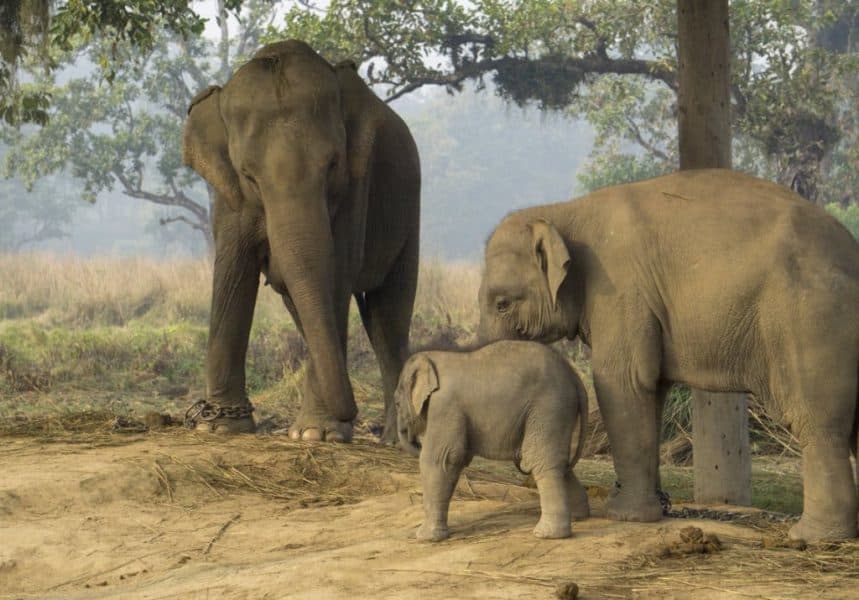
As if that’s not brutal enough, research has found that elephants who go through this process often suffer post-traumatic stress disorder. These captive elephants often die decades before their life-span because of health issues associated with carrying excess weight and being confined to a small space on a daily basis.
Elephant riding is not natural, and if you see any parks or ‘sanctuaries’ promoting this, I would stay far away. But don’t worry, there are still plenty of opportunities for ethical elephant encounters on your travels. Keep reading for 20+ places where you can ethically encounter elephants across Africa and Asia.
Elephant Encounters in Africa
Botswana
Chobe National Park, Botswana
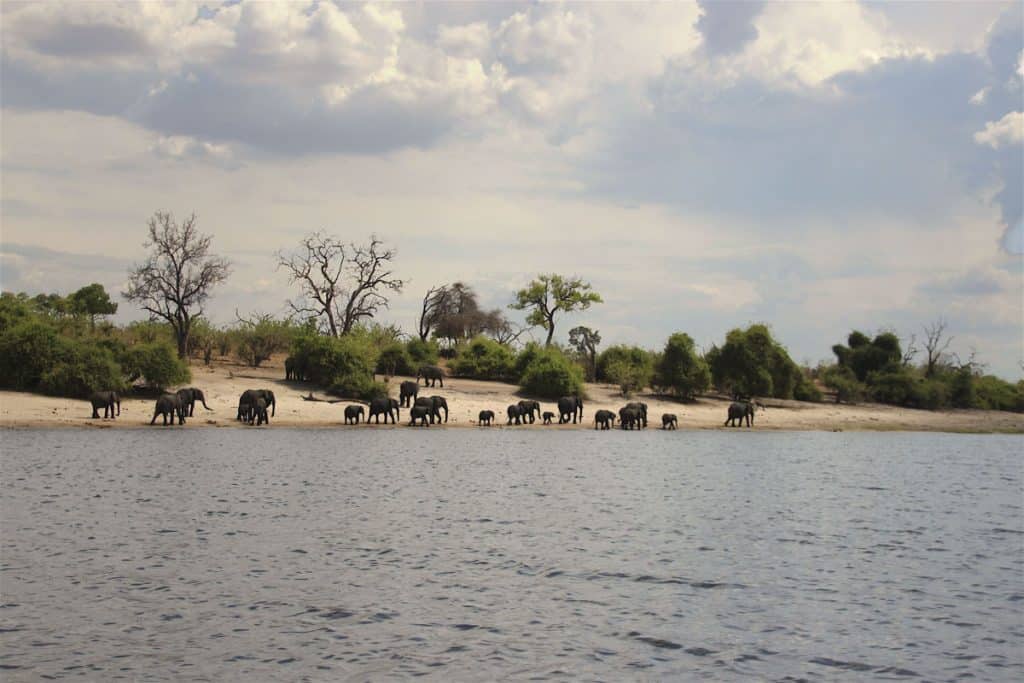
Recommended by Sabine of The Travelling Chilli
Going on a safari in Botswana is one of the best ways to encounter elephants in the wild. Located in the north-eastern part of the country, Chobe National Park is famous for seeing the African elephant. With nearly 100 000 elephants in the park that covers an area of around 11.000 km2, it can easily be said that Chobe has the highest density of elephants in the wild. Furthermore, the park is not fenced and the elephant families can freely roam into the parks of the neighboring countries.
The best way to see the elephants is on a boat cruise on the Chobe river. Especially during the dry months from June until December, as the elephants gather on the river banks to drink or bath. It’s not uncommon to see hundreds of elephants along the river, including family groups with baby elephants. The boat cruises last 3 hours and take place either during the day or in the evening.
Another way to visit Chobe National Park is by driving into the park with a 4×4 safari vehicle. It’s really nice as well, but you won’t see the large herds that you often see along the river’s edge. So for seeing elephants, my recommendation is to take a river cruise.
Elephant Sands, Botswana
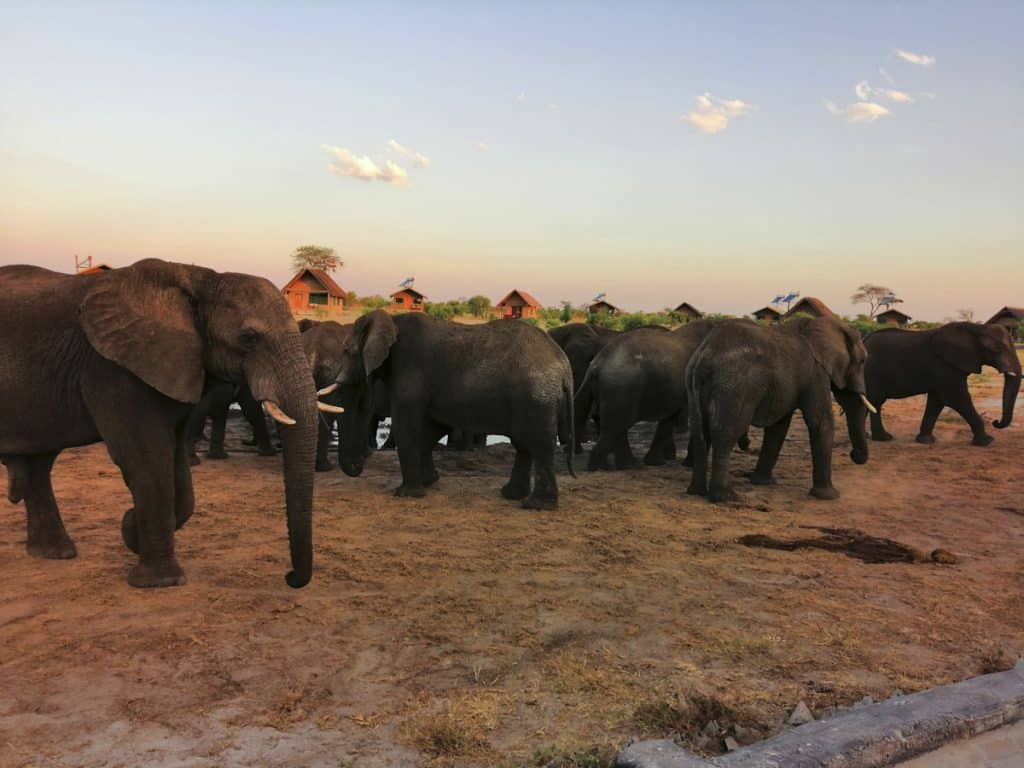
Recommended by Stuart Fahy of Just Passing Through
There are many places in Africa to see elephants in the wild but Elephant Sands is something unique. Located just off the main highway in the north-east of Botswana, this campsite surrounds a natural waterhole which attracts large herds of these impressive creatures.
There are both camping and lodge options at the site, so it’s possible to spend a day or two in the presence of the wild elephants as they wander around the area. You can even visit for the day from one of the nearby towns, and with no entrance fee it’s the perfect place to watch the enormous mammals up close. The lodge is around 1.5km from the main highway along a sandy track, so make sure you have something that can handle a little off-road in order to reach the site.
Early evening is the perfect time to stop by when there’ll be over 30 elephants strolling around as they wait their turn for a drink. It’s such a privilege to be able to observe the elephants and their interactions from so close. You gain an appreciation for not only their power but how surprisingly quiet they are.
A protected viewing area with bar, restaurant and swimming pool is the best place to watch from. However, the rest of the site is entirely open and you’ll find the elephants walking through the middle of the campsite as they please. So be careful where you pitch your tent!
Okavango Delta, Botswana
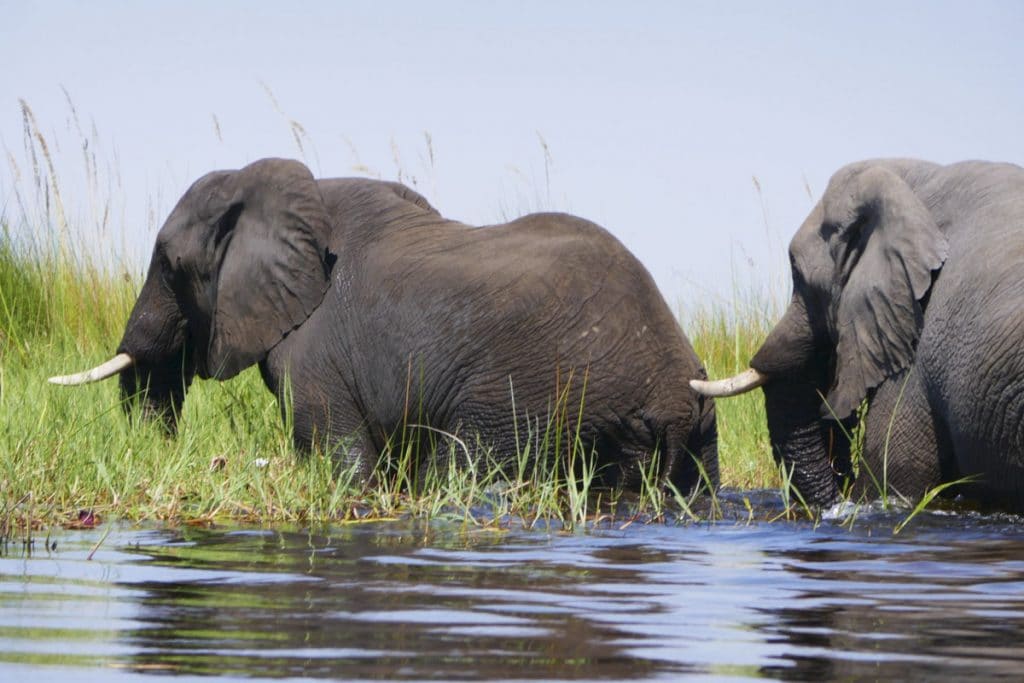
Recommended by Wendy of The Nomadic Vegan
The most incredible elephant encounter I’ve ever had was on a mokoro trip through the Okavango Delta in Botswana. A mokoro is a traditional dugout canoe used in this area. On a two-day, one-night mokoro trip, you will glide through the small channels of the river delta in your canoe, looking for wildlife along the way. Then you’ll camp overnight on an island in the delta, where you can go on a walking safari led by a local wildlife guide.
During most of our canoe ride to our camp, we saw lots of little frogs in the reeds but not that much else in terms of wildlife. But then, just as we were pulling in to camp, we saw three huge elephants in the narrow water channel that our boat was passing through! They looked on passively as we passed by and then continued to hang around our camp for the duration of our stay.
The elephants and other animals in the delta did not seem to be afraid of us at all. I believe this was in part because our guide Mogale did not carry a gun. Mogale is a devout animal lover, and he even became vegan as a teenager living in a local village, which is practically unheard of in Botswana! He told us he was confident the animals knew he would not hurt them.
The best time of year for wildlife viewing in the Okavango Delta is from July to October. A two-day trip costs 1,000 Botswana pula if organized through Old Bridge Backpackers.
Kenya
Ol Pejeta Conservancy, Kenya
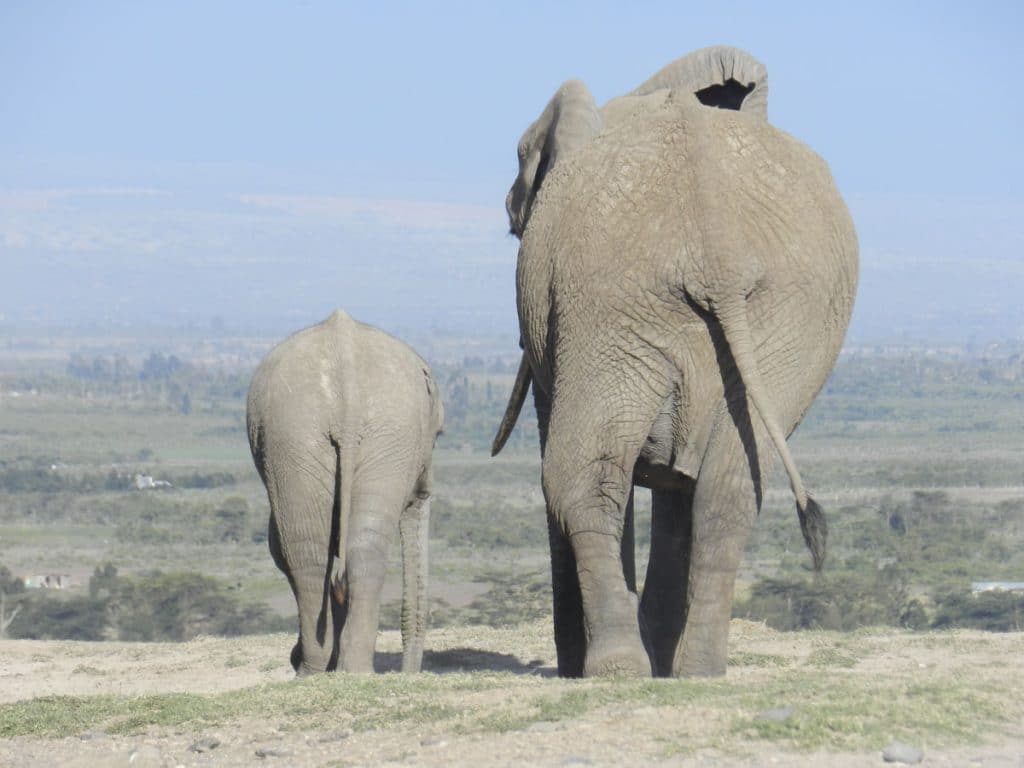
Recommended by Emily & Adam of Two Get Lost
Set against the backdrop of Kenya’s tallest mountain and straddling the equator, it is a wonder that Ol Pejeta safari park isn’t better known. Renown for its pioneering conservancy efforts, this is a safari park with a difference.
Animals are at the heart of every decision made here. The conservancy has added ‘wildlife corridors’ to ensure migratory animals can move safely in and out of Ol Pejeta to access great ecosystems. Their ecological monitoring unit closely observes and studies the behaviors of the elephant herds here to better understand how to protect them.
We saw huge herds of elephants on our visit and could see why they loved it here so much. Ol Pejeta is the only place in the world where you can see the last two existing Northern white rhinos and due to excellent security and proper ecological monitoring, the population of black rhinos here has hugely increased.
Another draw to this seemingly undiscovered gem of a safari park is how comparatively empty it is-you really will be animal watching rather than people watching. You can self-drive and camp here (prices from roughly £60 a night for non-citizens). Once night falls it’s just you and the cries of the wild animals. Watching a herd of elephants move silently past our tent in the moonlight is something we won’t forget in a hurry.
If you’re looking to see elephants somewhere that feels remote, real, and puts the conservation of endangered species above all else, then Ol Pejeta should be high on your bucket list.
Masai Mara, Kenya
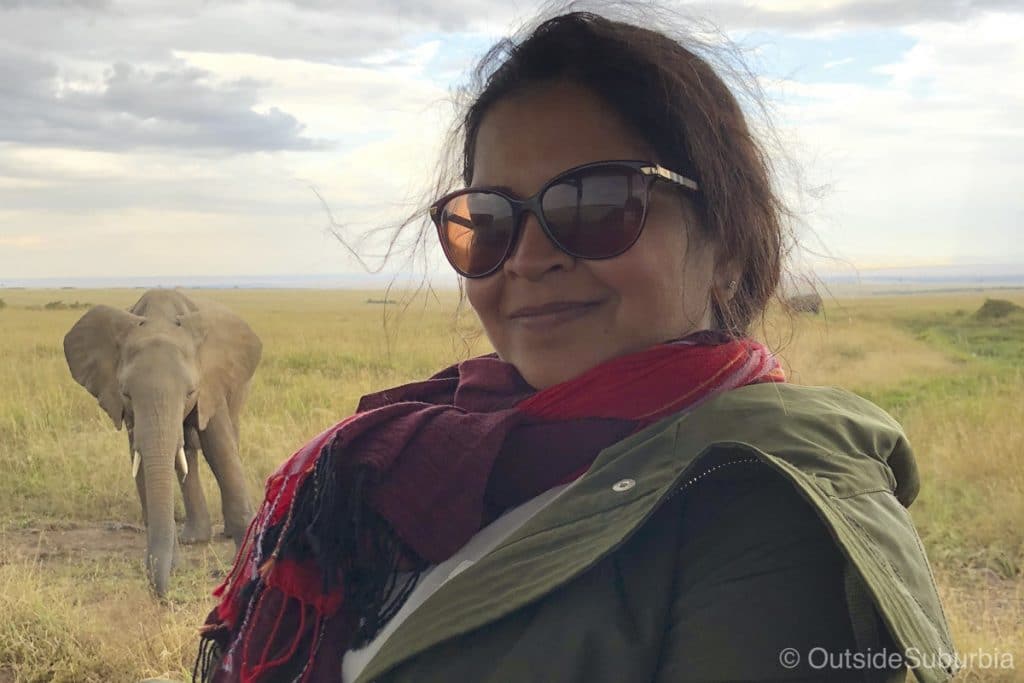
Recommended by Priya Vin from Outside Suburbia
Getting to Masai Mara, Kenya seems like a long and daunting trip but getting to see the animals in their natural habitat is worth that trek. Kenya is one of the first countries that established game preserves, has some of the best wildlife viewings, especially from June to September, when zebras and wildebeests migrate there.
Exploring the Maasai Mara National Reserve on a safari rewards you with views of gazelles, lions, cheetahs, impalas, sometimes a very rare black rhino and herds of elephants. We were lucky enough to see plenty of baby tembo (Swahili for “elephants”) during our Safari drives with Angama Mara. We even caught the beginning of zebra and wildebeests’ migration. The lodge packed us a picnic to enjoy on the plains.
The safari experience is varied, very flexible and included in the price of the stay. Wilson, our safari guide took us to see the different landscapes and the animals that called it home – we witnessed a zebra giving birth, a journey of giraffes, a pride of lions and many elephants. The elephant encounters we had in Masai Mara, Kenya was one of the best in my opinion.
Namibia
Etosha National Park, Namibia
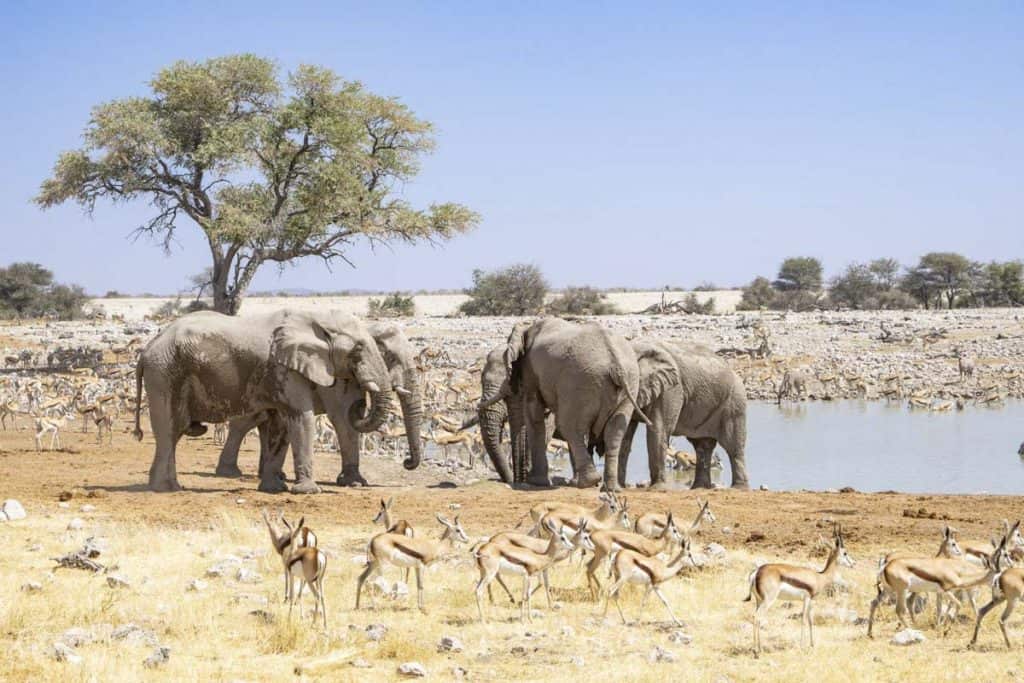
Recommended by Michael of Time Travel Turtle
Namibia’s Etosha National Park is one of the true success stories of wild elephant conservation in Africa. In the 1950s, there were just 26 elephants in the park. Now there are more than 2,500! The black rhino may be the most famous species here… but this is the domain of the elephants!
There are a couple of reasons why Etosha is such a special place to spot animals (and the elephants in particular). Firstly, there is not much foliage here, meaning you get can easily see the animals even if they are far away. Also, because it’s so dry, the park managers have created artificial waterholes, which give you just a few areas where the animals are more likely to be. Incidentally, these water holes are the main reason for the conservation success because it attracted the elephants off of private property, where they were being killed.
When it comes to the elephants, the ones at Etosha are famous for something very special – they sometimes cover themselves in white clay as protection from the harsh Namibian sun! You don’t see it all the time but, when you do, it’s an incredible sight to see them looking like statues or ghosts.
Etosha National Park is about 400 kilometers drive from Windhoek or 500 kilometers drive from Swakopmund. There are quite a few accommodation options inside the park, from a camping spot at N$350 (US$24) per person up to a luxury suite with waterhole views at N$3750 (US$250) per person. You can drive yourself around the park or take a safari tour with the local rangers. Entrance for a foreigner is N$80 (US$5.50) a day.
South Africa
Addo Elephant Park, South Africa
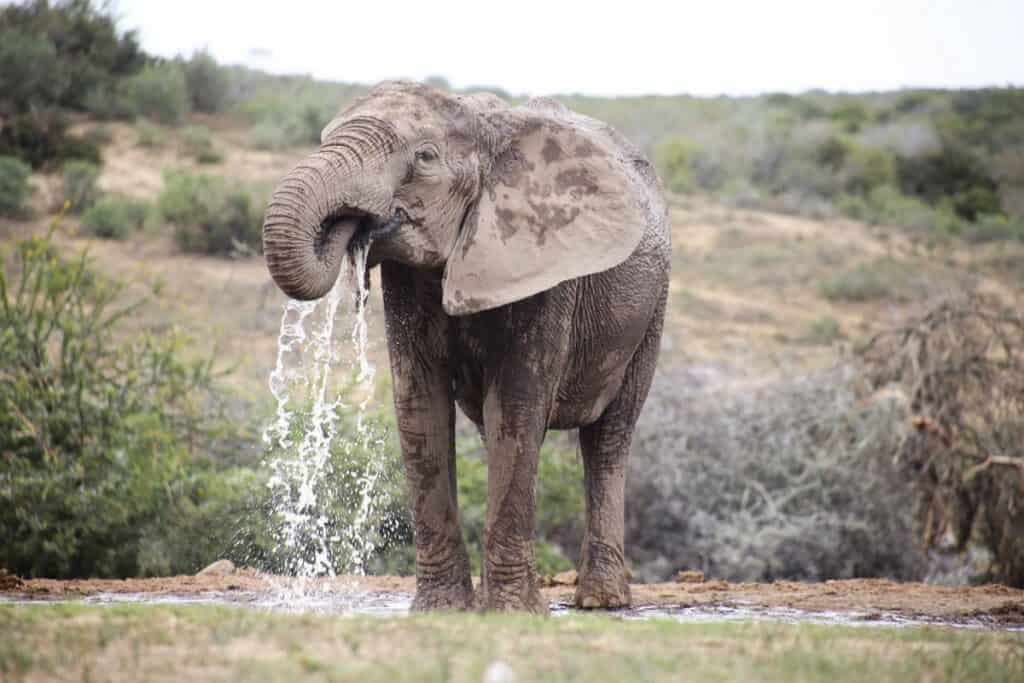
Recommended by Erin of Sol Salute
There is no better place to see elephants ethically in South Africa, if not the world, than Addo Elephant National Park. This small national park is home to over 600 elephants, and it’s virtually impossible to visit without multiple thrilling sightings.
The park is small enough to be seen in one day, in contrast to the enormity of Kruger National Park in the north. This is why many choose to visit Addo as a day trip while driving the Garden Route, but I recommend staying at least one night in or near the park.
The entrance fee is the 307 Rand conservation fee (around $20 US) for adults and half of that for children. If you’ve rented a car in South Africa, you can explore Addo on your own. The roads are in excellent condition and due to the sheer number of elephants, you don’t need an experienced guide to have great sightings. If you don’t have a car, there a number of guided game drives that will show you everything Addo has to offer.
If you love elephants, an ethical Addo Elephant Park safari is something you absolutely have to do.
Kruger National Park, South Africa
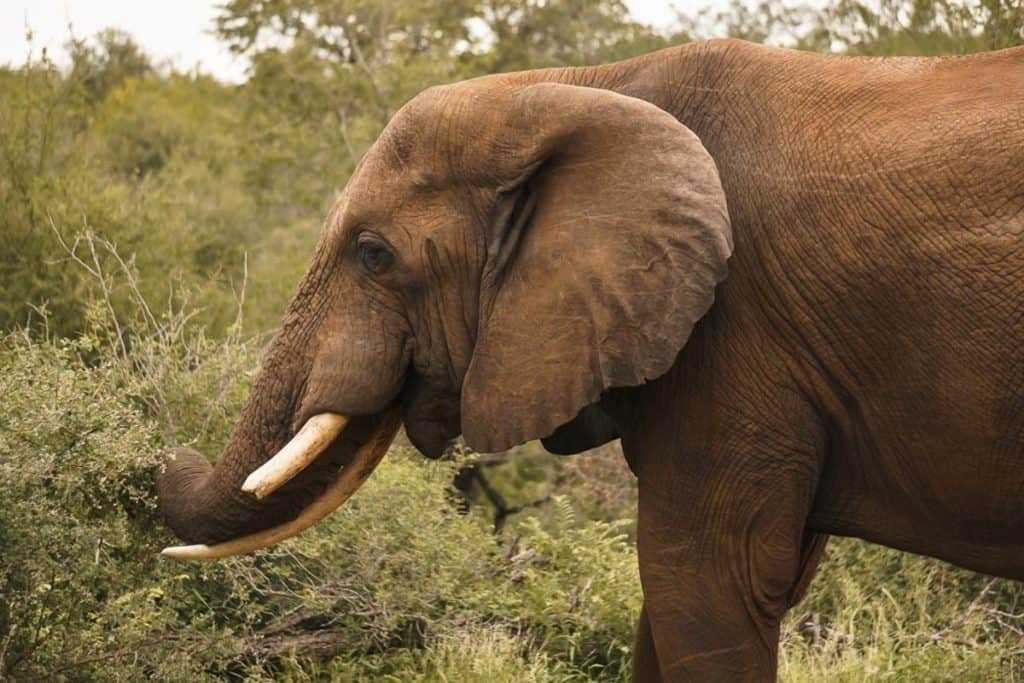
Recommended by Philip & Thea of Zen Travellers
Seeing a herd of elephants in the wild is an unforgettable experience and one of the best ways to have an ethical elephant travel experience. Doing a self-drive safari in South Africa’s legendary Kruger National Park is an ideal way to see majestic wild African elephants up close within an almost 20000km protected area.
The Park can be visited year round but is best during the dry months from mid-June to August. With over 3000km of paved roads, visitors can enjoy the park on their own schedule from the comfort of any vehicle ranging from a large off-road safari vehicle to a fuel-efficient, compact car. The fees that visitors pay to access the park are put toward conservation of the animal’s habitat and the salaries of the Park’s brave anti-poaching staff.
With a population of over 13000 elephants in Kruger National Park, chances are very good for people to have some up close elephant sightings when visiting the park. Just be sure not to get too close as there have been cases where elephants have flipped cars of people who didn’t respect their personal space!
Pilanesberg National Park, South Africa
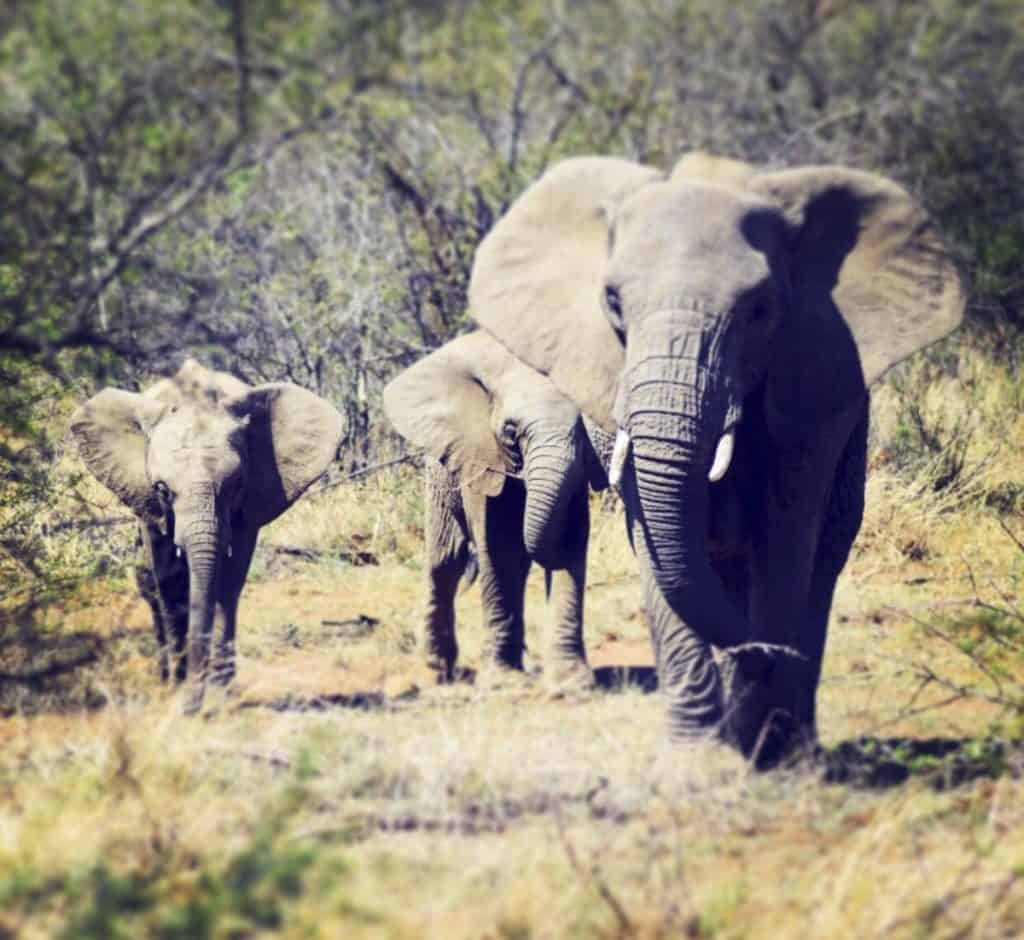
Recommended by Tracy of Tracy’s Travels in Time
The Pilanesberg National Park in beautiful South Africa is home to approximately 240 elephants. The park is the fourth largest in South Africa and is easily accessible from Johannesburg.
Situated in an ancient volcanic crater between the Kalahari and the South African Lowveld the Pilanesberg is an absolute must visit for animal lovers. The park is malaria free and is home to over 7000 animals including the so called Big 5. There are numerous accommodation options to choose from and opportunities to experience safaris either independently or with a group or guide.
The best time to visit the area is during the dry season between April and September. During these months water is scarcer so you have a better chance of spotting wildlife as they come to the waterholes to drink.
I recommend booking a few nights in the park as well as some guided safaris so you are able to relax and enjoy viewing the elephants and other wildlife in the Pilanesburg.
Tanzania
Tarangire National Park, Tanzania
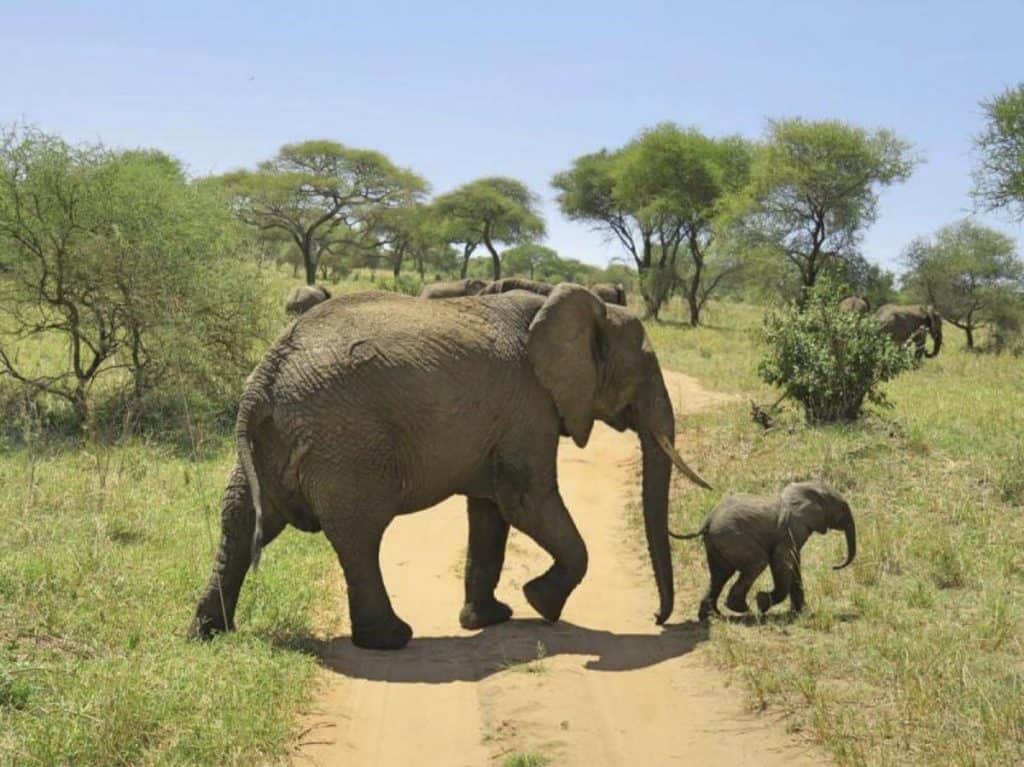
Recommended by Jackie Szeto & Justin Huynh of Life Of Doing
If you’re headed to Tanzania on a safari, one of the best places to see elephants in their natural habitat is Tarangire National Park. This park has the highest population of elephants per density due to its smaller size and abundance of baobab trees. During our first five minutes of driving in the park, we already spotted them!
It’s such an amazing sight to see herds of elephants along with the adorable babies roam around the savanna. The day time temperature is hot so they often cool off in the lakes or rest under the baobab. They love the baobab as they scratch the bark to drink water from the tree trunk during the dry season. Besides elephants, there are zebras, impalas, ostriches, and other animals in the park.
A visit to Tarangire National Park costs $45 USD for adults and $15 USD for children (ages 5-15). If you’re taking a northern safari circuit, then the ticket cost is included in your safari package. All guests must stay inside their Jeep or all-wheel-drive vehicle for safety. Your driver will also serve as your guide to help spot hard to find animals. It’s best to avoid the rainy season from March to May as the dirt paths are very muddy. Otherwise, the other months are a great time to visit
Uganda
Queen Elizabeth National Park, Uganda
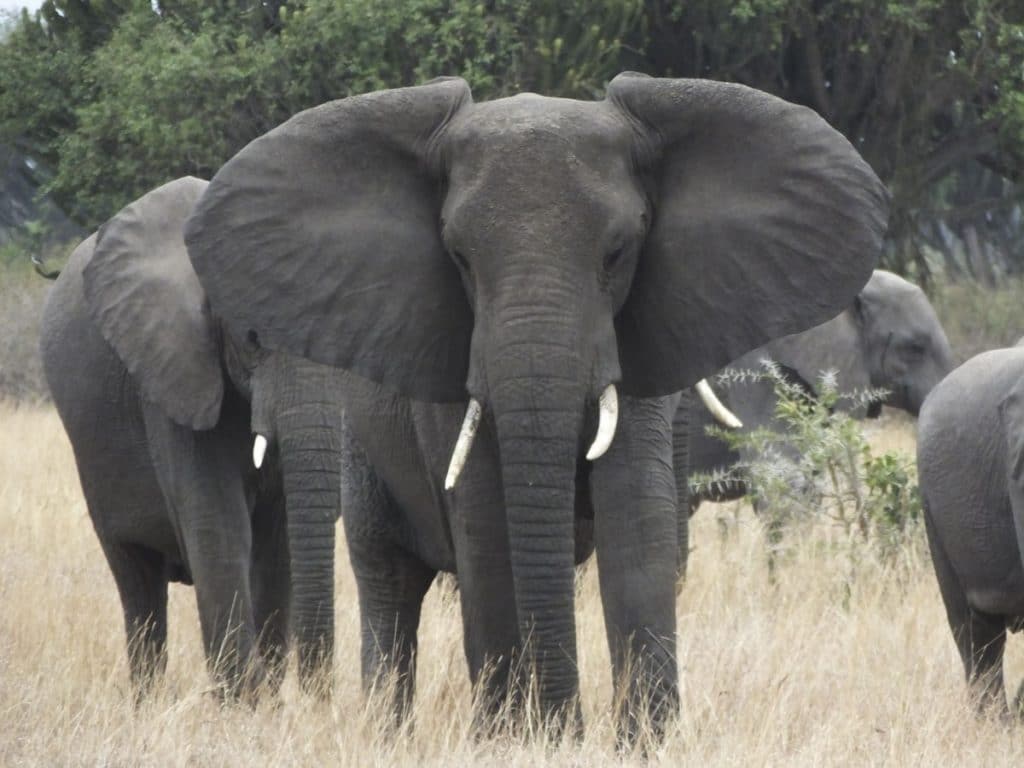
Recommended by Martin of Breaking Barriers
Waking up at sunrise on a morning to travel on a bouncy dirt road is not the typical idea of fun. But when you get to spend that morning with one of the world’s largest and yet most peaceful (unless provoked!) creatures, then the lost hours of sleep are all worth it!
Our trip brought us to Queen Elizabeth National Park in Uganda. This park has an area of approximately 2,000 km² and hosts a large variety of wildlife, including herds of elephants to gaze upon! Watching them lumber by your car or jeep you can’t help but marvel at their size and their family spirit, making sure their young are with them and protected by the herd at all times. They may come close to the vehicle but of course you are not allowed to get out as is the case in the majority of savannah parks in Africa.
While the elephants can take a bit of searching initially to find, the morning and the evening are the best time to see them as they are more active. During these times you will see them on the move to other parts of the park. The dry seasons in Uganda are from June to August and from December to February, these are the best times to visit the country. To access the park, unless you have already paid in advance through your tour company, the cost is US$40. This access is a 24 hour access.
Uganda is more widely known for its gorilla and chimpanzee population, but don’t forget to watch out for the other African wildlife like the elephants on your travels as well!
Elephant Encounters in Asia
Cambodia
Elephant Valley Project, Cambodia
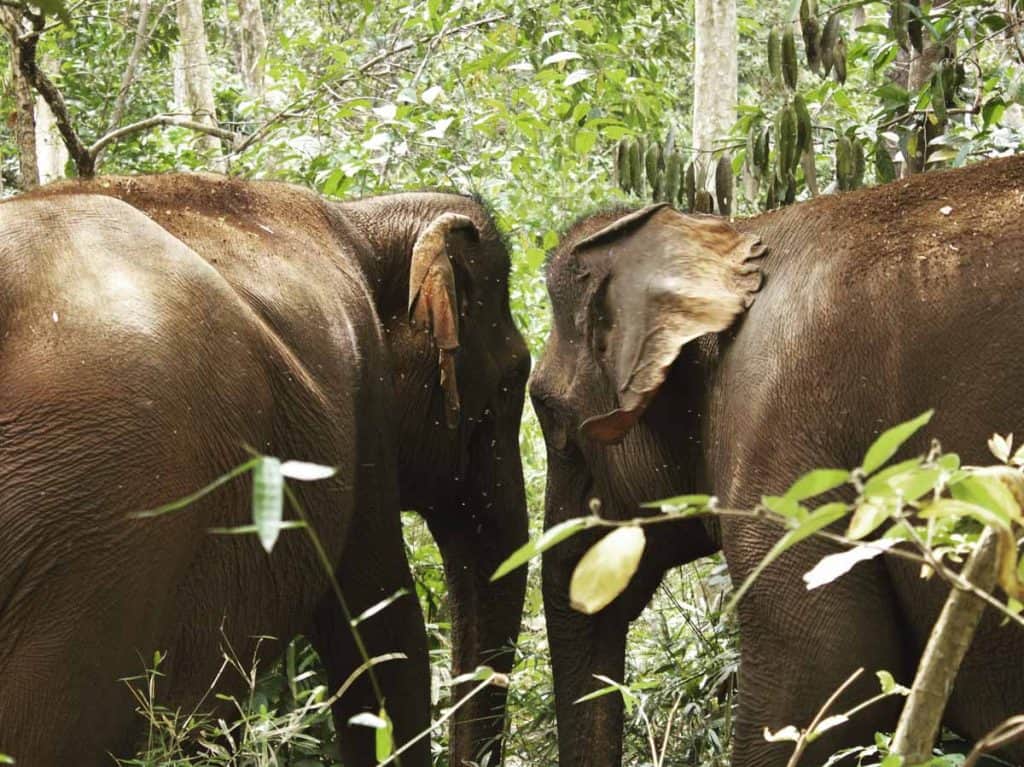
Recommended by Danny of What’s Danny Doing
There are all sorts of places to see and hang out with elephants in Cambodia.
However, one of the most impressively ethical I came across was in Sen Monorom, Mondulkiri Province, in the east of the country. As a quick aside, this oft-overlooked part of Cambodia is well worth the effort of getting there! It’s stunning. Anyway…
Called the Elephant Valley Project, this elephant sanctuary is where any elephant-friendly travellers head to see them in the wild. That’s right, it’s a sanctuary setup, but you’re deep in the jungle terrain of the wild east of Cambodia.
They elephants are in their natural environment, going about their daily lives as normal. You, as a human, stay well clear and observe them from a safe distance. There’s no handling, riding, washing, or feeding involved.
That might sound disappointing to some people craving a more tactile encounter. But these experiences don’t have the elephant’s interest at their heart. Elephant Valley Project is renowned for doing the opposite. As their site explains, their goals is to ‘give the elephants back their independence, natural behavior, and dignity.
There are all sorts of different ways to get involved. From day trips into the jungle to observe the herds, to overnight, multi-day experiences involving full hikes (make sure you take the right hiking backpack!) and involvement in the running of the sanctuary, it’s all available. Prices range from USD $95 to a few hundred dollars in line with what you decide to do.
This sanctuary is becoming increasingly well known. As a result, it pays to book early. They’re open throughout the year, regardless of the weather! Whenever you go, they’ll look after your every step of the way. Enjoy!
Laos
Mandalao Elephant Sanctuary, Laos
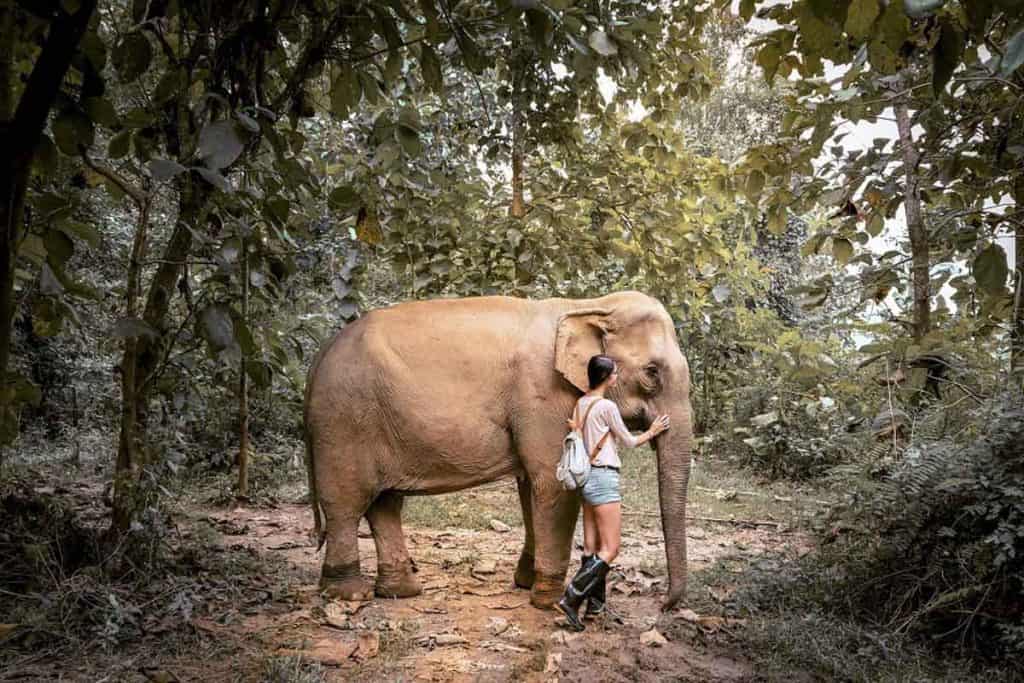
Recommended by Aurelia of Daily Travel Pill
If you’re traveling to Laos, a visit to the Mandalao Elephant Sanctuary is a must. Located in a dense jungle near Luang Prabang, Mandalao is a true sanctuary for its resident elephants.
Apart from taking excellent care of the elephants, Mandalo also functions on the principle of sustainability. The elephants’ daily food is provided by locals who are growing organic crops, full of nutrients and vitamins.
These majestic elephants living at Mandalao have around 80 hectares of forest to explore and they are free to do whatever they want. During your visit, you will be the one who follows the elephants, not vice versa.
The sanctuary only offers a few tours daily and only a small group of people is allowed on each tour. In this way, you will have a closer interaction with the animals without disturbing them in any way.
Mandalao Elephant Sanctuary is a truly unique place, where the well being of the elephants always comes first.
Thailand
Elephant Nature Park
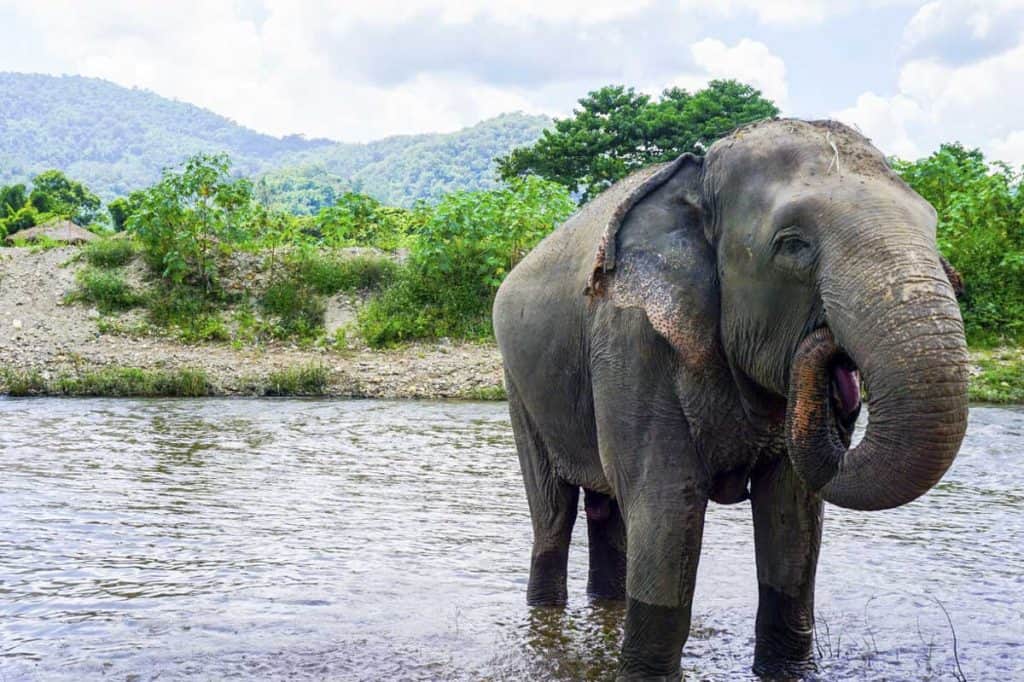
Recommended by Jess and Ron of Unearth The Voyage
A visit to the Elephant Nature Park in northern Thailand is a great experience if you are looking to spend some time with elephants in an ethical way. The Elephant Nature Park has rescued elephants from illegal logging operations and other ‘sanctuaries’ in Thailand where the elephants were forced to endure being ridden and ‘the crush’- a physically and mentally harmful practice used to get elephants to listen and submit to humans.
Most of the elephants at the Elephant Nature Park have obvious signs of physical (and some even mental) problems. Tourists can visit the Elephant Nature Park to spend some time watching the elephants and learning more about them and the situation of elephants in Thailand.
There are lots of different programs you can choose from and the cost ranges depending on what you would like to do while visiting. For a single day visit, it costs around $80 USD and goes up from there to around $200 USD for a much more involved behind the scenes look at the sanctuary. You can also spend the night at the Elephant Nature Park as a visitor or as a volunteer! The best time to visit is from November to early April as it is the cooler and dry season.
Mahouts Elephant Foundation
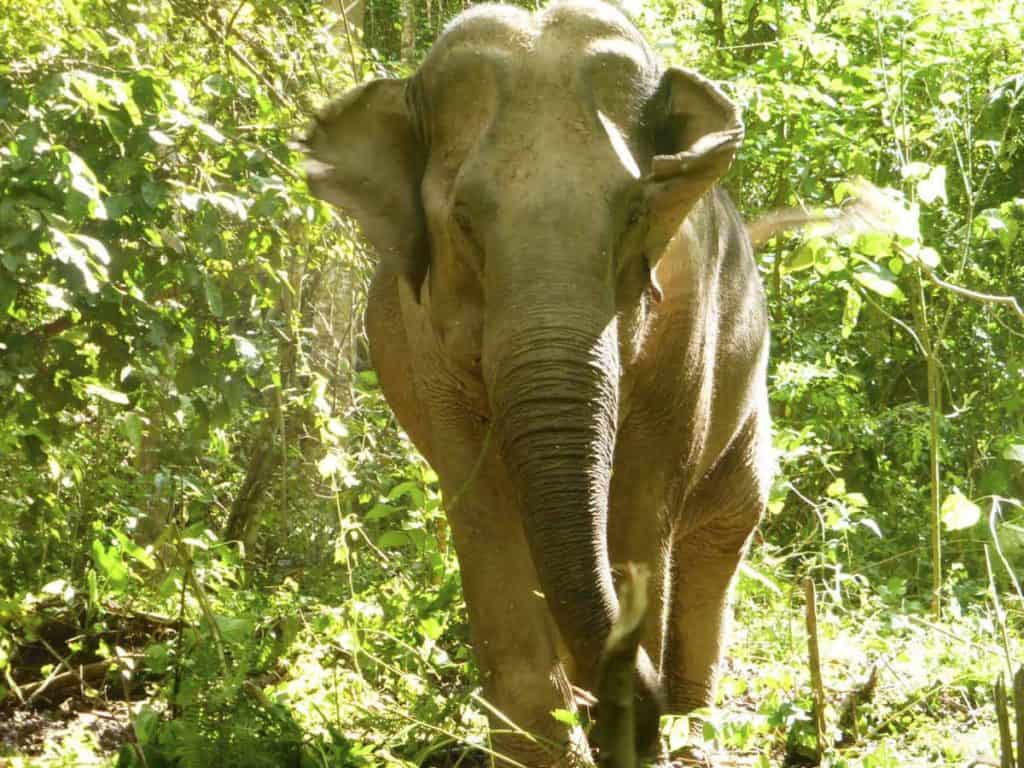
Recommended by Emma Walmsley of Small Footprints, Big Adventures
My family and I loved our visit with the Mahouts Elephant Foundation. It was truly an ethical elephant experience which benefited a local community while teaching us about elephants and life in the hills of Northern Thailand. We stayed with a family in their homestay program, and trekked for hours to find the small herd of elephants in the nearby forest. The elephants are free to roam all day and forage for their natural food, and they are obviously so happy and healthy living there.
Their mahouts keep an eye on them each day and use their knowledge to take visitors to them and keep us at a safe distance. There is no touching, bathing or feeding the elephants, just observing them happily living their lives.
Most of the herd used to live in work camps, but were bought by the Mahouts Foundation who walked with them for days from Chiang Mai back to the forest to live. I love that this program supports them to live in the forest, supports their Mahouts to live with their families, and supports the community of Huay Pakoot, too.
The Mahouts Foundation offer several experiences open all year round, and prices vary according to the length of the stay. Discounts are offered for young children and the prices include transfers from Chiang Mai (four hours away), meals and homestay costs.
Elephant Green Hill, Chiang Mai
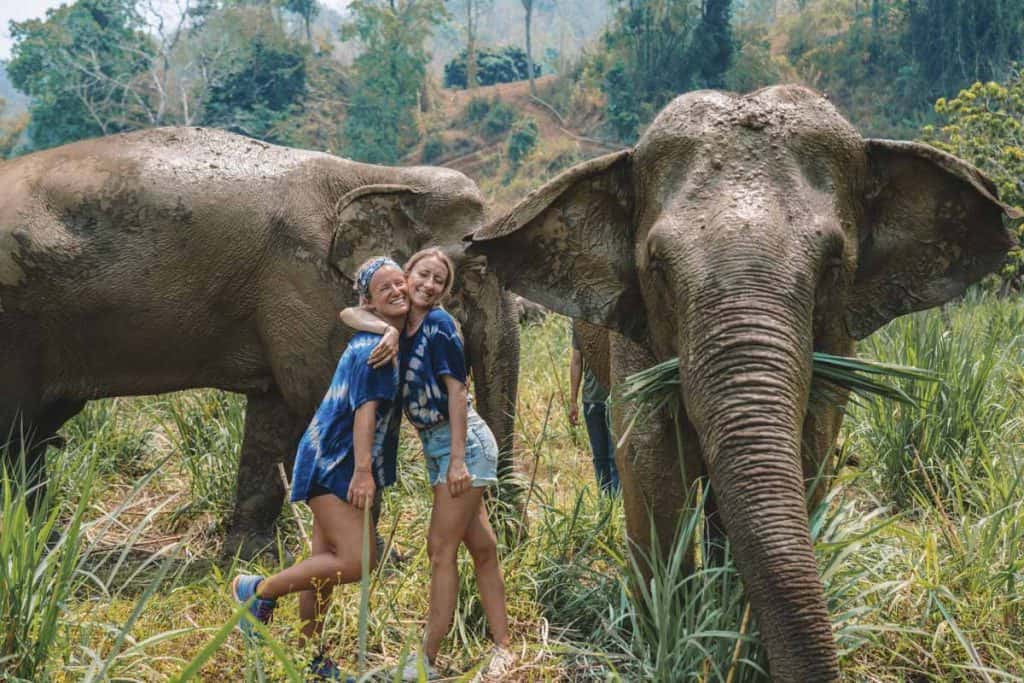
Recommended by Greta of Greta’s Travels
With the rise of ethical animal tourism there are lots of places now where you can see elephants in an ethical manner. Elephant Nature Park in Chiang Mai, Thailand, was one of the first drivers in ethical elephant encounters, and many other sanctuaries have followed suit seeing its success.
All around Chiang Mai there are a number of repurposed riding camps, which have joined ENP in a new “saddle-off” project. Elephant Green Hill is one of these such sanctuaries. The sanctuary is much smaller than ENP and home to only three elephants, but I found it to be a much nicer experience since the groups of tourists are also smaller. When I visited me and my friends were the only three people there, so we got to enjoy our time in the elephants as if it was a private day!
The full day experience costs 2,500 THB and includes hotel pick up and drop off, lunch, and you will spend the whole day with the elephants. Throughout the day you will prepare food for the elephants, walk in the forest with them and bathe with them. You could tell the elephants were happy and it was one of my favourite days of my Thailand trip.
Elephant Valley Project, Chiang Rai
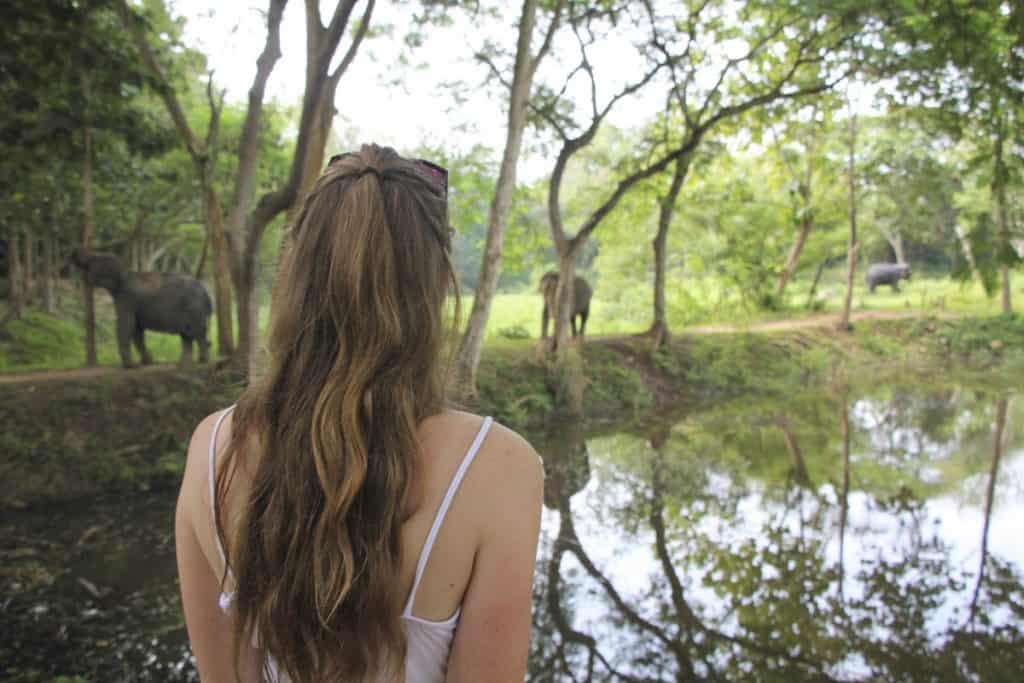
Recommended by Anna of My Travel Scrapbook
No visit to Thailand is complete without meeting a beautiful grey and gentle giant, an elephant. Sadly, Thai elephants are an endangered species. There are now only around 1000 Thai elephants in the wild. Yet there are over 3000 elephants, classed as ‘domesticated’ elephants, which work in logging or tourism. Many of these are abused and treated very poorly even in so-called sanctuaries.
The word ‘sanctuary’ is very loosely used, and many so-called sanctuaries are more like zoos or circuses. There are a few places which are trying to do what is best for the animals and not the tourists. For example, Elephant Valley Project in Chiang Rai in Thailand is one of Thailand’s most ethical elephant centers.
The owner of the center picks you up from your accommodation and takes you just outside of the city to the Elephant Valley Sanctuary. Upon arrival, you are told about their vision, the work they are doing and that their ultimate goal is to create an elephant safari. Hearing their aims you know you have chosen the right place. There is no riding, playing or washing the elephants here. You are allowed to watch the elephants just being elephants.
There is also a limit at the Elephant Valley Project Thailand as to how close you can be with the gorgeous creatures. Most of the time you watch them from afar. At snack time though you are allowed to feed them bananas for 5 minutes, allowing a little time up close with the elephants. Elephant Valley has five elephants at present. Some of the animals used to be used in circuses and the others were in the logging industry.
Whilst the sanctuary is by no means perfect it is certainly going in the right direction. It is a thoroughly wonderful experience seeing these majestic giants. You must visit Elephant Valley when you go to Chiang Rai and support this fantastic venture.
Sri Lanka
Elephant Transit Home, Uda Walawe National Park
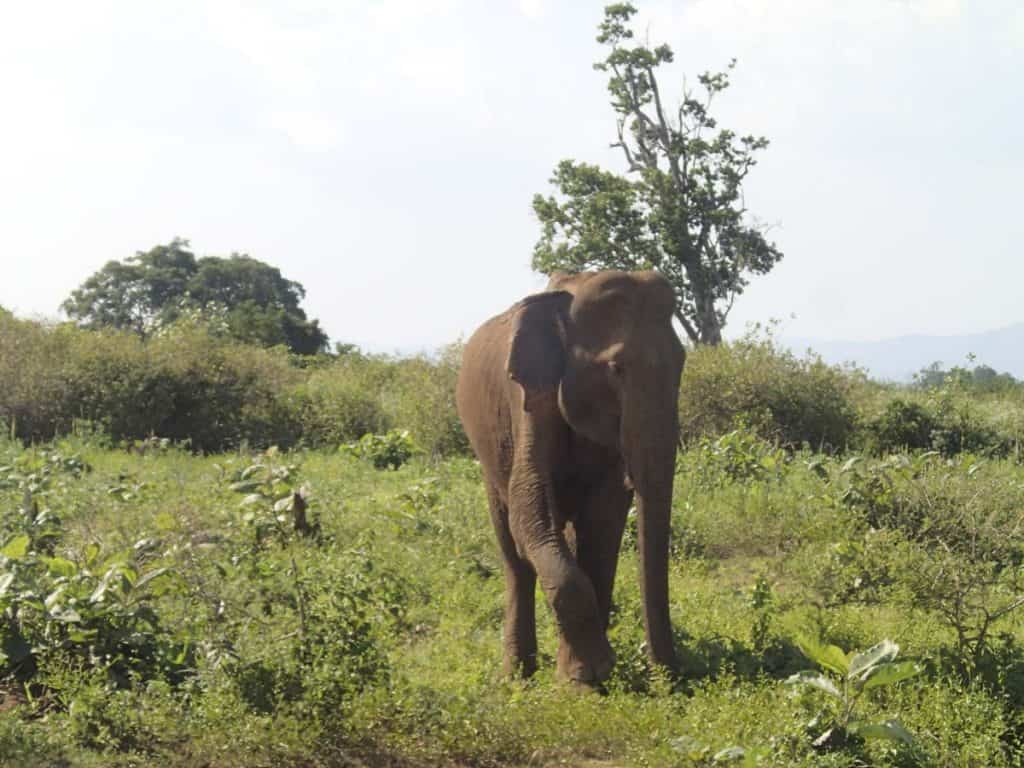
Recommended by Warren Dobe of Sling Adventures
Ath Athuru Sevana translates in English to ‘Elephant Transit Home’ which is situated on the edge of the Uda Walawe National Park in Sri Lanka. This home is designed to care for orphaned elephant calves that have been found in the 33,000 hectare park. The elephants are not held in any enclosure, yet they return to be fed every three hours voluntarily. Once they reach the age of 5, they are re-introduced to the park, usually in batches, so that they form groups which can be adopted into a larger herd.
Visitors can view the elephants being fed four times a day (9am, 12pm, 3pm, 6pm). Entry is 500 Sri Lankan Rupee ($5 USD) and well worth the visit. There is a small museum on the premises telling the story of the Elephant’s role in the history of Sri Lanka and its development from prehistoric times. There is also a large skeleton statue at the entrance to understand the unique physical structure of the Asian elephant.
Safari tours are also available separately into the park where you will see countless Elephants in the wild along with buffalo, crocodiles, deer, the occasional leopard and countless birds. Uda Walawe National Park has been designed to keep the peace between locals and Elephants which has had its challenges. The Elephant Transit Home is there to protect the next generation of Elephants so that Uda Walawe remains a true sanctuary for the magnificent elephant for years to come.
[irp posts=”1509″ name=”A day with the Elephants in Udawalawe National Park”]
Kadulla National Park
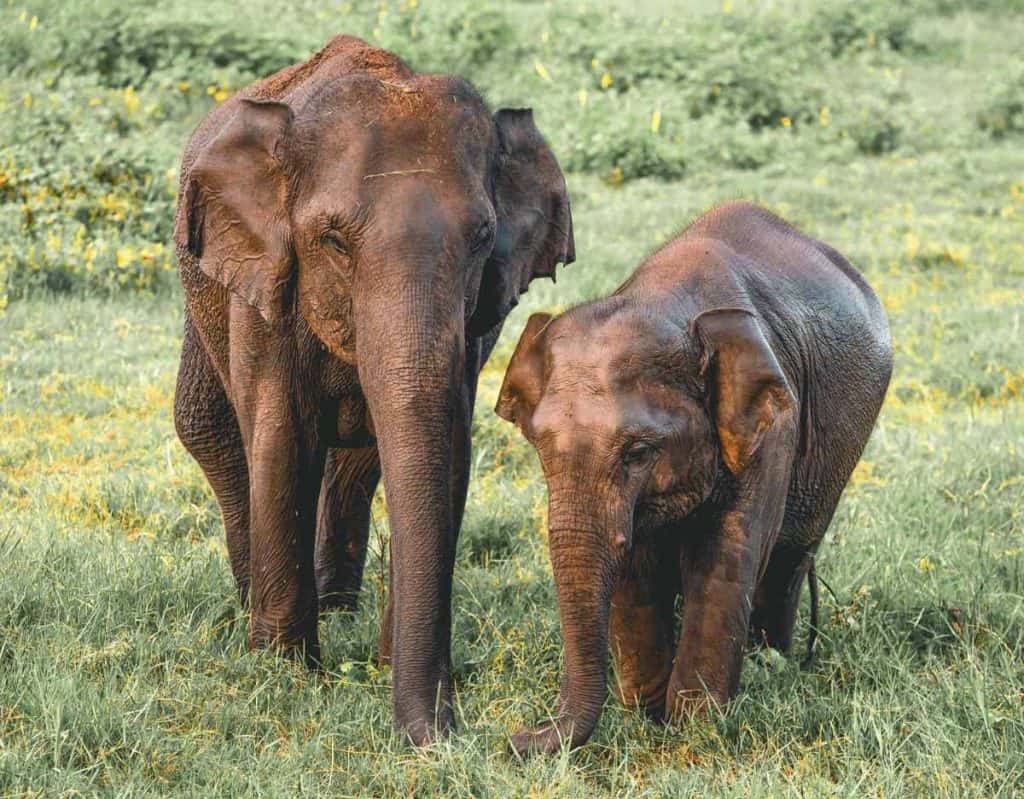
Recommended by Dave from Jones Around The World
Sri Lanka is truly a top destination for elephant lovers, and I’ll never forget my afternoon on a jeep safari through Kaudulla National Park! For some reason, I remember foolishly thinking that we wouldn’t even see an elephant and that if we did we’d probably only see one or two. Now, I realize that was just silly because this is one of the main national parks in Sri Lanka to witness hundreds at the same time!
After a rather bumpy ride for 20 minutes or so through winding jungle paths, we came into a clearing and witnessed our first elephant. Our group got so excited to see one, but as we continued further into the wide open plain, I quickly realized we were literally surrounded by elephants in every direction!
It was breathtaking, and a travel experience I’ll cherish forever. I loved that we were there simply to witness them in their natural habitat, and we weren’t bothering them at all. We’re not even feeding them, but we did get rather close which was fascinating! It was a relatively cheap wildlife safari, but one of my favorite things to do in the country! If you do go, try and book an afternoon trip, as it’ll be cooler and more enjoyable than if you do in the humid heat typically found in Sri Lanka!
Minneriya Park
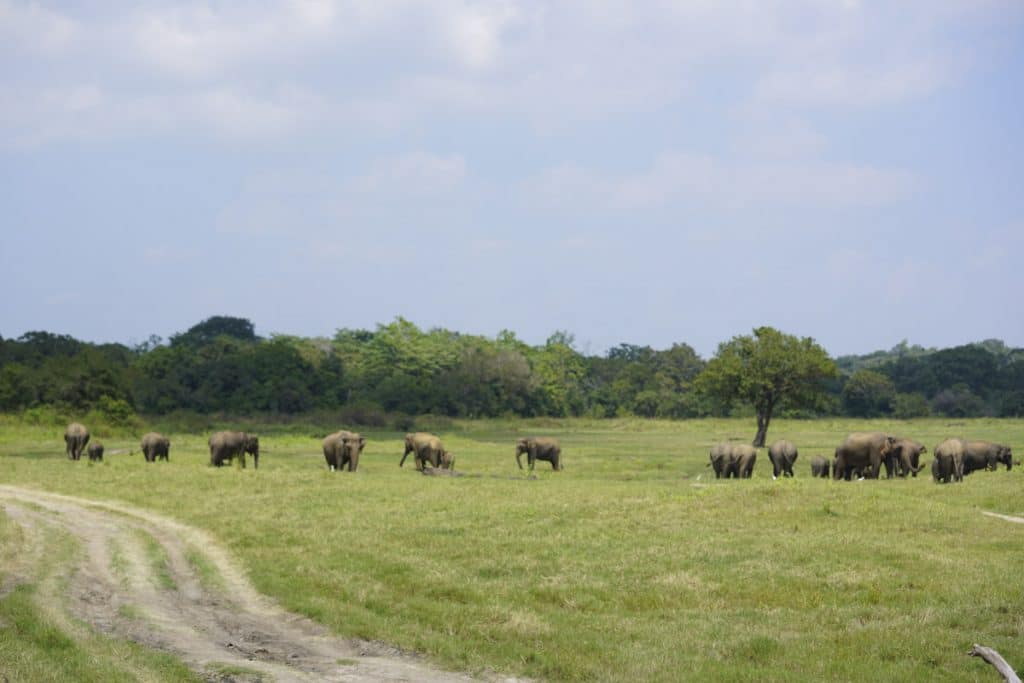
Recommended by Tiffany from a Girl and her Passport
When I visited Sri Lanka, I wanted to fulfill my dream of seeing elephants in the wild. I had done some research but hadn’t been able to find one that wasn’t a park and that the animals were not ridden. My driver suggested Minneriya National Park as an alternative.
The elephants are wild but have access to the park which is a reserve for wildlife due to the large reservoir located inside. Every day the elephants trek there to drink the water. Because it is a national park, seeing the animals is heavily regulated. You must go in a hired car that is driven by approved park drivers. There are several levels of comfort in the car. I went for the least expensive not because I didn’t care about comfort but because it had a fully open roof to stand up in.
Once you get close to the reservoir the drivers have rules to follow. You cannot drive across the paths of the elephants or get drive up to them. They can approach you though. When I arrive there was a small group of elephants with several babies getting a drink. Later more elephants came at this group was much larger, probably around 30.
Minneriya National Park is close to Sigiriya Rock so it is good to combine these when visiting. I arrived around 11 at Minneriya and was one of two tours. It is better to go early so you beat the crowds and the elephants go early to escape the heat.
Kataragama Park
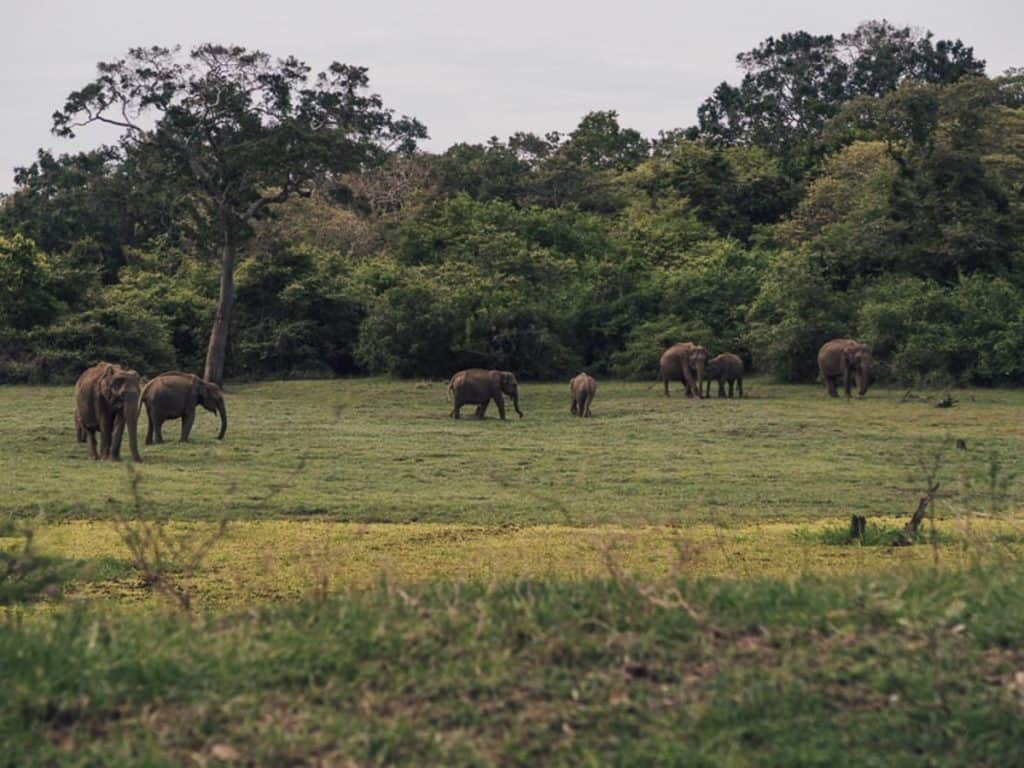
Recommended by Bradley & Cazzy of Dream Big, Travel Far
If you want a place to see elephants in the most natural way possible, then a visit to Sri Lanka should be top of your list. There are plenty of safari spots in Sri Lanka, but if you want to see beautiful elephants roaming around for free, then head to Kataragama. It’s best to rent your own tuk tuk so you can visit them on your own, but after lunch time, you’ll find lots of elephants just roaming around, on the road into Kataragama. Sometimes they even block the road, so you need to be super careful!
This is because Kataragama is submerged between a lot of national parks, so the elephants just tend to roman about wherever they want. We spotted lots of them and went into a field to get a little closer and found a family of elephants, with babies and all. It was such an amazing experience and to just see them in their natural habitat was comforting. Make sure you don’t get too close to them, as they can become startled, but you can easily hide behind trees. Do not forget your camera!
[irp posts=”1747″ name=”7 amazing ways to see wildlife in Sri Lanka”]
Malaysia
Plant4Borneo Elephant Project in Tawau, Sabah, Borneo
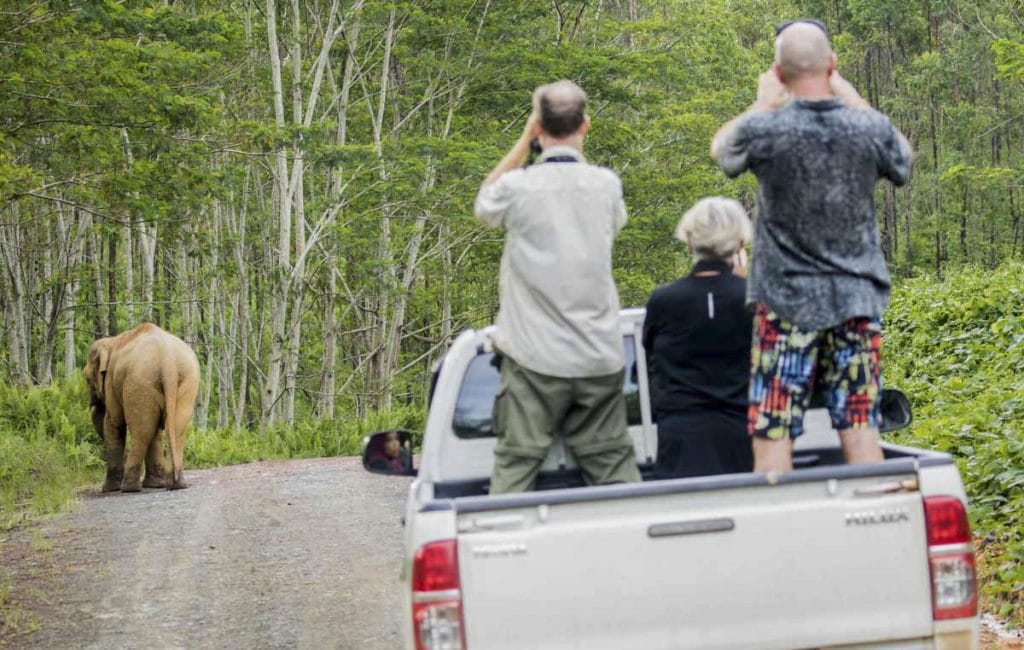
Recommended by Marco Ferrarese of Monkey Rock World
In less-visited Tawau, the jump-off point to the Semporna islands in the southernmost corner of Sabah, Malaysian Borneo, elephant conservation has embraced luxe tourism to reforest a wildlife corridor and save the local herds of wild pygmy elephants.
Less than 8 months ago, the Plant4BorneoElephants project has launched new wild elephant-spotting safaris in a huge tropical softwoods plantation on the edge of lesser-visited Tawau. This new experience is definitely one of the best alternative tours in Sabah.
Because of deforestation and a lack of pristine wildlife corridors they can use to move around as they look for grazing grounds, these days Borneo elephants often take up residence in plantations. Sabah Softwoods is the first that, instead of chasing off the three herds of wild elephants that took a liking to their vast grounds, started using tourism to collect funds that support a long-term reforestation project initiated together with local NGO 1StopBorneo Wildlife. The aim is to replant trees an create a wildlife corridor that will eventually connect the plantation to the nearby Danum Valley forest reserve, giving the elephants – and other endemic wildlife — a new and safe passage into Sabah’s most celebrated, most pristine rainforest.
The experience is totally ethic and developed with animal sustainability in mind: the elephants must be observed at a minimum distance of 15/20 meters, there’s absolutely no contact between visitors and animals, and rangers always patrol and control the interactions. The elephants are left undisturbed in their natural habitat, and it can take hours to find them (or not) on the vast plantation grounds.
As the cherry on top of the eco-tourism cake, guests stay in a very nice cottage-style accommodation with swimming pool set on the plantation grounds, experiencing a real “offbeat plantation stay” which include meals, one adventurous elephant safari in the back of a pick-up truck (about 2/3 hours), and participate to tree planting in the wildlife corridor on the next day. It costs RM1700 and includes a trip to nearby Tawau Hills Park, a national park teeming with wildlife and a research site for the rare Borneo clouded leopard
Conclusion
I hope this post has given you some insight into elephant captivity, and why it’s important to make sure you are giving your tourism dollars to a place that is genuinely helping these majestic creatures instead of hurting them.
Big thanks to all the bloggers who helped make this post possible. I am so happy to learn about these ethical places to see elephants, and will definitely be checking them out in my future travels.
Have you had an elephant encounter before? Did you feel good about it after? Let me know in the comments below, I’d love to hear about your experience!
Like it? Pin it for later!
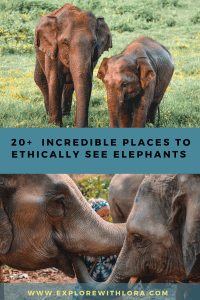
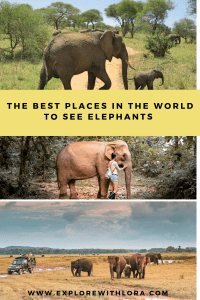
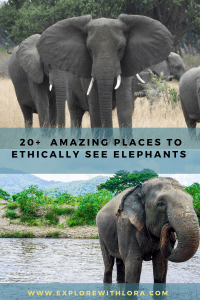

[…] Elephant Valley Project in Cambodia is one of the most ethical elephant encounters in all of Southeast Asia. The project was started to rescue, rehabilitate, and return overworked […]
You have provided good information. Really very helpful. keep this good work going.
Glad you thought so!
Loved your article thank you. We visited Sri Lanka and did a trip to wash the elephants in a local river…simply stunning experience. Our kids loved it and it was an amazing experience for all of us. My son learnt to surf while we were there and my daughter spent most of her time chasing the butterflies!
Glad you enjoyed Sri Lanka! It’s such a great country, especially for learning to surf.
Thanks for sharing